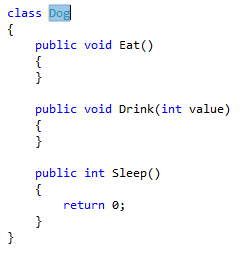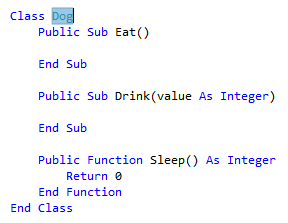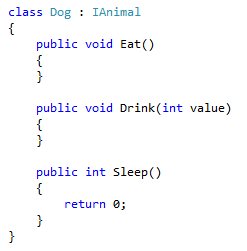Extract an interface refactoring
Applies to: ![]() Visual Studio
Visual Studio ![]() Visual Studio for Mac
Visual Studio for Mac
Note
This article applies to Visual Studio 2017. If you're looking for the latest Visual Studio documentation, see Visual Studio documentation. We recommend upgrading to the latest version of Visual Studio. Download it here
This refactoring applies to:
C#
Visual Basic
What: Lets you create an interface using existing members from a class, struct, or interface.
When: You have members in a class, struct, or interface that could be inherited by other classes, structs, or interfaces.
Why: Interfaces are great constructs for object-oriented designs. Imagine having classes for various animals (Dog, Cat, Bird) which might all have common methods, such as Eat, Drink, Sleep. Using an interface like IAnimal would allow Dog, Cat, and Bird to have a common "signature" for these methods.
Extract an interface refactoring
Place your cursor in the class name.
C#:

Visual Basic:

Next, do one of the following actions:
- Keyboard
- Press Ctrl+R, then Ctrl+I. (Your keyboard shortcut may be different based on which profile you've selected.)
- Press Ctrl+. to trigger the Quick Actions and Refactorings menu and select Extract Interface from the Preview window popup.
- Mouse
- Select Edit > Refactor > Extract Interface.
- Right-click the name of the class, select the Quick Actions and Refactorings menu and select Extract Interface from the Preview window popup.
- Keyboard
In the Extract Interface dialog box that pops up, enter the information asked:

Field Description New interface name The name of the interface to be created. The name will default to IClassName, where ClassName is the name of the class you selected above. New file name The name of the generated file that will contain the interface. As with the interface name, this name will default to IClassName, where ClassName is the name of the class you selected above. You can also select the option to Add to current file. Select public members to form interface The items to extract into the interface. You may select as many as you wish. Choose OK.
The interface is created in the file of the name specified. Additionally, the class you selected implements that interface.
C#:


Visual Basic:

